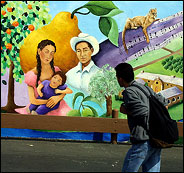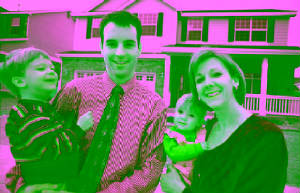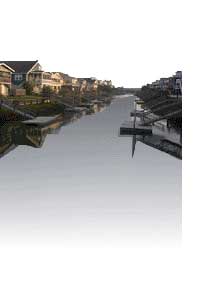|


The San Fernando Valley had a population 1,696,347 in 2000. A recent estimate by the Los Angeles County Urban Research
Unit and Population Division puts the 2004 population at 1,808,599. The largest communities and cities in the valley are Glendale,
North Hollywood, Van Nuys and Burbank, each with more than 100,000 residents. Despite the San Fernando Valley's reputation
for sprawling, low-density development, the Valley communities of Panorama City, North Hollywood, Van Nuys, Reseda, Canoga
Park, and Northridge have numerous apartment complexes and contain some of the densest census tracts in Los Angeles.
Latinos and whites are nearly even in numbers, combining to comprise more than four out of five Valley residents. In general, communities in
the northeastern, central, and northwestern parts of the Valley have the highest concentration of Latinos. Whites live mainly
along the communities along the region's mountain rim. Glendale has an influential and very large Armenian community. San
Fernando, Tarzana, Calabasas, and Hidden Hills are quite homogeneous in racial makeup. Asian Americans make up 10.7% of the population and live throughout the Valley, but are most numerous in Chatsworth, Panorama City, Glendale,
Porter Ranch and Granada Hills. African Americans compose 5.1% of the Valley's population, living mainly in Lake View Terrace, Pacoima, Reseda and Chatsworth. Another large ethnic element is the Iranian community with 200,000 people living mainly in west San Fernando Valley.
Although poverty rates in the San Fernando Valley are lower than the rest of the county (15.3% compared to 17.9%), eight
San Fernando Valley communities have at least one in five residents living in poverty. While Pacoima is widely known in the
region as a hub of suburban blight, other cities like Mission Hills, Arleta, and Sylmar have poverty rates well below the
regional average, even lower than neighborhoods populated by a higher number of White residents.
Many wealthy families live in the hills south of the Ventura Boulevard; as a result, the phrase "South of the Boulevard"
has become a commonly used buzzword in local real estate.

Latinos and whites are nearly even in numbers, combining to comprise more than four out of
five Valley residents. In general, communities in the northeastern, central, and northwestern parts of the Valley have the
highest concentration of Latinos. Whites live mainly along the communities along the region's mountain rim.
|
